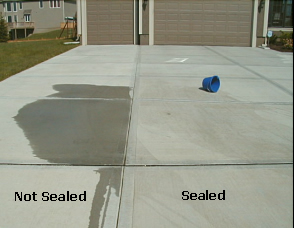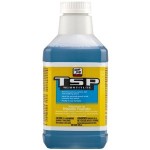Concrete is fairly maintenance free. However, applying a protective coating can lengthen the lifespan and keep the concrete slab, apron, steps, or sidewalk looking nice. Living in Minnesota, we experience some frigid cold winters, sizzling summers, and everything inbetween. (Go to https://drivewayrepairinc.com/freeze-thaw-and-how-it-effects-your-concrete.html to read about freeze/thaw effects.) Knowing how to properly apply the coating, as well as preparing the concrete is crucial in obtaining good results. Surface preparation varies from job to job and with different types of coating. Be sure to read and follow the recommendations provided by the coating manufacturer. Failure to comply with those specific directions can result in a waste of time and money.
First and foremost, the surface of the concrete must be free of all loose dust, dirt and other debris. This can be done by sweeping, vacuuming, air-blasting, pressure washed or cleaned off with the garden hose. If sweeping, use a clean stiff-bristled industrial broom. If you are vacuuming, using an industrial heavy-duty vacuum that removes all dust from the concrete surface. Air-blasting you should use a compressed air stream at 80-100 psi, through a nozzle held about 2 feet from the surface. Make sure the air stream is oil free. When using a pressure washer or garden hose, use clean water at a pressure high enough to remove dust, dirt, and water-soluble surface contaminants. These methods shouldn’t alter the concrete’s surface profile. For oil or grease stains, first scrape the surface where the stain is located. Then using detergent or non-solvent emulsifier, take a stiff-bristled brush to remove any remaining contaminants. Using a solvent to remove oil or grease can spread contaminants or wash them deeper into the concrete.
Before applying the sealer, you must wait 24 hours for the concrete to completely dry. If it rains, wait another 24 hours. Water on the driveway will dilute the siloxane sealer, which limits the amount of sealer that gets into the concrete substrate.
Spray, roll, or brush the sealer onto the driveway. Use the tool you prefer, but keep in mind that a roller applies the sealer faster than a brush. A garden sprayer is faster than a roller. Don’t worry about getting some of the sealer on your grass or garden plants. If you get some of the product on metal or windows, simply wash it off right away with soap and water. Use a sponge to clean the surfaces.
Apply the concrete sealer until a faint white color appears on the driveway. If any of the sealer “ponds” in a section, spread it evenly before letting it dry.
Plan to apply the sealer when the weather is going to be dry, as water cannot touch the surface of the driveway for 24 hours. Keep cars and people off the driveway for 24 hours as well. Although the sealer dries in a few hours, the 24-hour rule is important to follow to ensure the sealer adheres properly to the driveway.
When the sealer cures it becomes bonded to the driveway and will provide protection from damage for years. Sealing a driveway is a good investment of time and money.

As you can see below sealing concrete really does make a huge difference in appearance.









